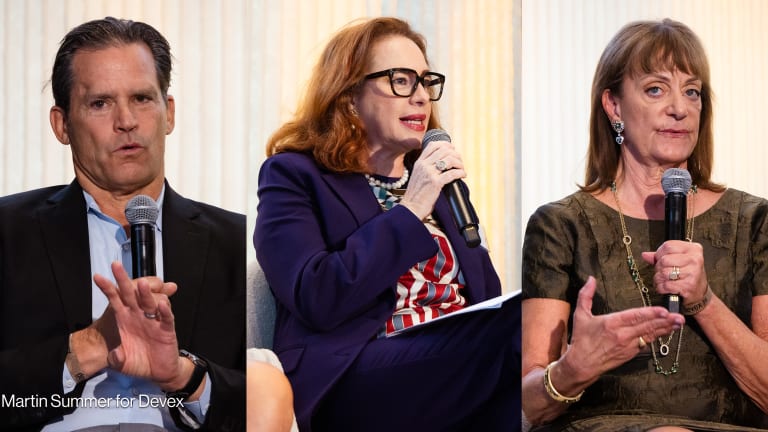What can USAID learn from the DOD's approach to innovation?
The U.S. military’s approaches to circumventing bureaucracy, making itself more accessible to the private sector, and engaging entrepreneurs could offer lessons for the development agency.
During his time serving in Afghanistan, U.S. Air Force Lt. Gen. Steve Kwast lost 70 people in a year bringing water bottles to forward operating bases over roads with improvised explosive devices, he said. Now retired from the military, Kwast is president at Genesis Systems, a company developing new technology to generate water from air at industrial scales. While he is eager to partner with the U.S. Agency for International Development, Kwast is starting with a number of innovation efforts launched by the Defense Department — including some he helped to stand up — to get the technology to market. “We knew if we went straight to USAID, we would never get there,” he said. “But the second we ruggedize this equipment so it’s sufficient for the kind of cultural and political headwinds it will get when we take it to Africa and other places where USAID needs sustainable water, we’re going to go there.” “We’re really just scratching the surface on what collaboration could look like across the whole of government with this startup ecosystem.” --— Col. Nathan P. Diller, director, AFWERX U.S. government agencies have a reputation for being difficult partners for startup organizations, which lack the people needed to get through all the paperwork required for partnership or procurement and seek to move quickly. Both DOD and USAID have introduced new initiatives to lower the barrier to entry for new partners. But experts told Devex the military has made more progress than the development agency in working with startups on mission critical technology and said DOD’s approaches to circumventing bureaucracy, making itself more accessible to the private sector, and engaging entrepreneurs could offer lessons for USAID. Missed opportunities USAID should consider how the Defense Department and intelligence community are supporting commercially viable artificial intelligence and machine-learning innovations, said Ben Leo, CEO at Fraym, a geospatial data platform that has worked with both USAID and DOD. “These programs deploy billions of dollars each and every single year to find promising new technologies in the private sector and match them specifically to war fighter and intelligence analyst requirements,” he said in an April hearing on innovation in development policy that was convened by a U.S. House Foreign Affairs subcommittee. But USAID remains largely focused on incentivizing ad hoc innovations rather than leveraging technology to address core needs that span the agency, including gathering localized data, Leo said. Where there is a company with a commercial technology solution that promises development impact, USAID can play a valuable role, but “that’s not the only pathway to scale in international development,” said Jonathan Ng, acting innovation division lead of the Innovation, Technology, and Research Hub at USAID’s Bureau for Development, Democracy, and Innovation. Over the years, USAID has also tried a number of techniques to engage private sector innovators in international development challenges, including with its new Private Sector Engagement Hub. But Ticora Jones, acting director of the research hub, said “the expansiveness” of issues USAID is working on makes it more challenging to identify companies with technology that might transform the way the agency works. One of the challenges USAID faces is “identifying the problem owners,” said Pete Newell, a retired U.S. Army colonel and innovation expert who is CEO at BMNT, a technology incubator that helps early stage companies address national security missions. “Our first and biggest challenge with them was getting past the people in the staff and the bureaucracy to actually understand who owned the problem,” he said of his past work with USAID. “Everybody’s got great ideas of the way things ought to be done, but if you don’t do the work to first source and curate the problems and the ecosystems around the problems, you’re going to continue to do one-off things.” Newell said USAID should have people who are tasked with sourcing problems, going through ideas, and narrowing a large number of submissions down to a small number or prospects. If the agency devoted even a small fraction of its budget to that, he said, its expenditures across the portfolio could be far more efficient. A ‘front door to the federal government’ DOD launched the Defense Innovation Unit in 2015 to accelerate commercial technology for addressing national security challenges. The agency was responding to the reality that private sector innovation far outpaces what DOD could develop or fund on its own. DIU focuses on six areas: artificial intelligence, autonomy, cyber, human systems, commercial space, and advanced energy and materials. “Commercial industry is where a lot of the private investment is going, and the DOD and government needs to leverage this investment,” said Mike Madsen, director of strategic engagement at DIU. A recent example is a digital tanker planning tool that automates the process of determining when fighter jets and refueling tankers should meet in the sky, which was traditionally done by pilots and planners rearranging magnets on a whiteboard. DIU uses an acquisition tool called the Commercial Solutions Opening, which requires significantly less paperwork than the Federal Acquisition Regulation, a set of rules that covers many government procurement contracts for the U.S. military. It posts opportunities online for a few weeks, asks each company to provide a five-page white paper or a 15-slide PowerPoint deck on the technology it has to offer, and then narrows down submissions. While USAID has a number of programs that invest in innovation, including its open innovation program Development Innovation Ventures, several tech startup leaders agreed that it does not have a program that supports commercially built technologies, allows end users to test these technologies, or provides companies with a pathway to scale. When companies do find ways to work with USAID, the agency can be a valuable partner in deploying technology in low-resource settings, said Benjamin Thelonious Fels, the founder and CEO of Macro-Eyes, a company that uses artificial intelligence to make supply chains proactive. “We’ve been able to demonstrate results in some of the most challenging settings on Earth,” he said of work in Nigeria, Sierra Leone, and Mozambique. “As our work unfolded, very often in partnership with USAID, we developed capabilities the DOD found valuable.” Thelonious Fels said he hopes to see more companies work with both USAID and DOD, as Macro-Eyes does. Many of the requirements for economic development — including access to the internet, energy, and water — are also essential for the military in locations around the world, said Col. Nathan P. Diller, director at AFWERX, an initiative that promotes a culture of innovation within the U.S. Air Force and has supported both Genesis Systems and Fraym. AFWERX and its work for the Air Force, as well as other innovation efforts within DOD or NASA, have best practices shared between them on how to engage with industry. “We say this is a front door to the Air Force,” Diller said. “We are finding this is more of a front door to the federal government.” Diller said he has not been directly in touch with USAID but noted that he does see the synergies — not only because they share an interest in some of the same technologies, but also because they could both benefit from these more flexible procurement approaches. “Most companies are finding this is a very quick and much less painful way of working with the federal government than we’ve ever seen before,” he said. “We’re really just scratching the surface on what collaboration could look like across the whole of government with this startup ecosystem to do great things domestically and abroad.”
During his time serving in Afghanistan, U.S. Air Force Lt. Gen. Steve Kwast lost 70 people in a year bringing water bottles to forward operating bases over roads with improvised explosive devices, he said.
Now retired from the military, Kwast is president at Genesis Systems, a company developing new technology to generate water from air at industrial scales.
While he is eager to partner with the U.S. Agency for International Development, Kwast is starting with a number of innovation efforts launched by the Defense Department — including some he helped to stand up — to get the technology to market.
This story is forDevex Promembers
Unlock this story now with a 15-day free trial of Devex Pro.
With a Devex Pro subscription you'll get access to deeper analysis and exclusive insights from our reporters and analysts.
Start my free trialRequest a group subscription Printing articles to share with others is a breach of our terms and conditions and copyright policy. Please use the sharing options on the left side of the article. Devex Pro members may share up to 10 articles per month using the Pro share tool ( ).
Catherine Cheney is the Senior Editor for Special Coverage at Devex. She leads the editorial vision of Devex’s news events and editorial coverage of key moments on the global development calendar. Catherine joined Devex as a reporter, focusing on technology and innovation in making progress on the Sustainable Development Goals. Prior to joining Devex, Catherine earned her bachelor’s and master’s degrees from Yale University, and worked as a web producer for POLITICO, a reporter for World Politics Review, and special projects editor at NationSwell. She has reported domestically and internationally for outlets including The Atlantic and the Washington Post. Catherine also works for the Solutions Journalism Network, a non profit organization that supports journalists and news organizations to report on responses to problems.








